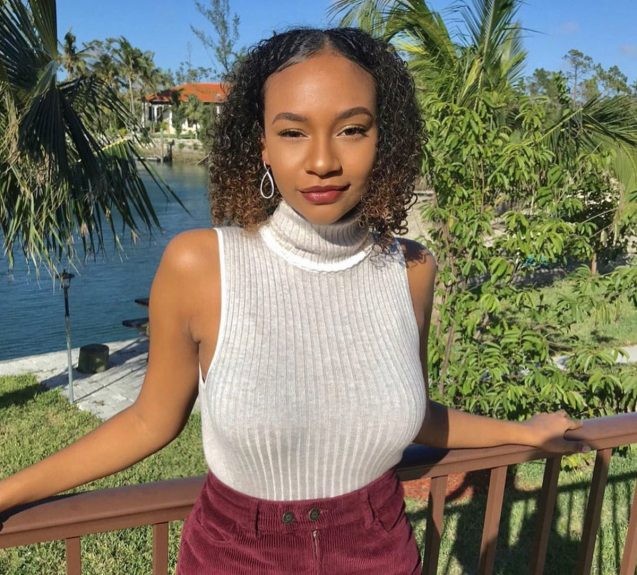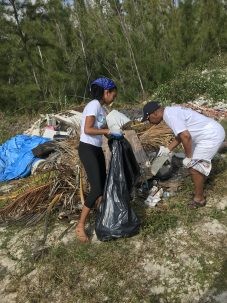Q&A With Lauren Ritchie on Intersectionality in the Climate Movement
The undergraduate student/blogger/activist shares her thoughts on the changing role of social justice within the climate movement.

Lauren Ritchie is a third-year undergraduate student from the Bahamas, studying sustainable development and political science at Columbia University. As an intern with the Earth Institute, Ritchie works with Kailani Acosta, Benjamin Keisling and Kuheli Dutt on advancing diversity, equity, and inclusion at the Lamont-Doherty Earth Observatory.
Ritchie’s work has led to the creation of Columbia Climate Conversations, a new panel series designed to engage the undergraduate community in critical but under-discussed parts of the climate movement. The first panel took place on Thursday, November 19 and featured three well-known activists of color in an hour-long conversation about the topic of intersectional environmentalism, an approach to climate action that highlights diversity, inclusion, and accessibility. Over the next few months, subsequent panels will be dedicated to the topics of youth activism, disability awareness, and small island sustainability. Panels are open to all Columbia students and faculty, as well as the public.
In May 2020, Ritchie also founded The Eco Gal (@itsecogal), a blog and Instagram account about global climate justice with over 50,000 followers that has received international acclaim. Through digital graphics and online articles, The Eco Gal promotes inclusive climate action and aims to make sustainable living more accessible by amplifying the voices of marginalized communities. Ritchie is also a writer and content strategist for Brown Girl Green, a youth ambassador for Plastic Pollution Coalition, an ambassador for the Global Wildlife Conversation, and the co-host of the podcast Black Girl Blueprint.
In the Q&A below, Ritchie discusses her motivations for creating The Eco Gal and the Columbia Climate Conversations, the changing role of environmental and social justice within the climate movement, and how to advance intersectionality within and outside of the classroom.
How did you first become interested in climate change?
I am from Grand Bahama, the northernmost island in the Bahamas. When you grow up on a small island and spend ample time outdoors, you truly develop an appreciation for the natural environment. I would go to beach clean ups almost every weekend and I would generally hear about protecting our coral reefs and our mangrove ecosystems in most of my classes at school. On top of that, the hurricane season can be extremely detrimental. Wanting to protect my island and my country is the real root of where my love for climate action comes from. As I got older, that love progressed to a love for addressing social issues as well.
How does your identity influence the lens through which you understand the climate crisis?
Being Bahamian has always made me look at my coursework with the understanding that there are so many different layers to sustainability and the climate crisis. Whether you are from the Global North or the Global South affects the ways you can impact the climate crisis and the way the climate crisis impacts you. On top of being the only Bahamian in the room, I am also often one of the only Black women in the room, which comes with its own responsibilities. Because of the way the sustainable development curriculum is set up, I know that if I don’t bring up the topic of environmental justice, then nine times out of ten it will not get talked about. That is a lot of responsibility on me as a person of color and a Caribbean woman to say, “My experience here is valid too.” If I’m not in that space, then that story may never get heard. It can be exhausting to have to do that extra work, but I’m also grateful to have the opportunity. It has made me more well-rounded when it comes to talking about these issues.
Before you began working as an intern with the Earth Institute, you founded The Eco Gal. Could you tell me a little bit more about what inspired you to create the platform?

After spending so much time in my sustainable development classes, I went home to the Bahamas because of COVID-19, and no one was talking about climate change. Eco Gal was supposed to be a small account to write blog articles and share tips about sustainability. My target audience was Bahamian youth. Then, as the platform grew, people related to it and learned from it much more than I expected. It was around the same time as the murder of George Floyd, and it was important for me to use my platform as much as I could to share information and educate others on the need for social justice. The thing about Eco Gal is that it is a community. The people I am able to reach now by using social media are people who would not have necessarily been in the circles where traditional social justice work took place. I wanted Eco Gal to be a digestible and relatable way to talk about complex social and climate justice issues — something that young people could actually learn from and be a part of.
Why is intersectionality so critical to the climate movement?
I immediately think of the quote, “You can’t have climate justice without social justice.” It is true in so many different regards. The fact of the matter is that the climate crisis does not affect everyone in the same way. It’s not just that some areas of the world are going to get hit harder. Socioeconomic status, race, gender, immigration status, and disability are fundamental things to consider when thinking about how people will be able to access resources, deal with environmental injustices, and survive the climate crisis. Intersectionality is essential in terms of understanding that nuance and tackling the systems that are oppressing certain groups of people.
How would you characterize the current role of equity and justice within the climate movement?
When I first made Eco Gal, all the sustainability accounts that were recommended to me and the people who were following me were middle-aged white women. There were no accounts of people of color, particularly Black women in the U.S. With the rise of diversity and representation in the climate movement, I have seen a lot of progress in terms of the many talented, brilliant, amazing people gaining a platform to share their stories and educate others. BIPOC are finally getting the recognition and the compensation they deserve. But there is still a long way to go. It’s important to recognize that there are centuries of environmental racism and injustice that went into the systems we have today, and that isn’t going to disappear overnight. Beyond the recognition of individuals, there is systemic dismantling that needs to take place still to push this movement for intersectionality forward.
How do you see that shift towards intersectional climate action mapping on to what Columbia does as an institution?
It’s important to recognize that there are centuries of environmental racism and injustice that went into the systems we have today, and that isn’t going to disappear overnight.
Columbia defines itself as a leader in climate and environmental justice, but I wonder where that energy is when it comes to representation. How have I never had a single Black professor in my sustainable development classes? How are there barely any people of color on the Earth Institute or Lamont staff? Why are environmental justice classes not a requirement for the sustainable development major? Columbia has a long way to go, I will be transparent about that. But I also see the potential. As an elite institution, an institution that holds power, Columbia has a responsibility to be a trailblazer. Other universities will follow suit because of what Columbia is doing, and they have the resources to do a lot of good work.
Could you describe what the Columbia Climate Conversations are and what led to their creation?
The Columbia Climate Conversations are about having discussions as a community in ways that we haven’t been. I’ve been invited to do a lot of great things because of Eco Gal, including panels and initiatives hosted by other universities. In my head, I started to wonder why Columbia wasn’t doing more to engage with the undergraduate community on intersectionality. For the most part, the Earth Institute has their demographic of people who are regularly contributing and engaging with their content, and those people tend to be white. I did an extensive amount of research into what the Earth Institute was doing in terms of diversity. I saw what conversations weren’t being had, and I thought, “Let’s talk about that.” As undergraduates, we are all 18, 19, 20 years old. Let’s bring in people who we can look up to, 18-year-olds who are doing mind-blowing work, and let’s learn from them.
What stands out to you most about the project?
Part of what I love most about the Columbia Climate Conversations is that these were the ideas that I had before I even got the internship. When I interviewed for this position, I had my whole plan laid out. I knew I wanted to start a series of panels — a panel on small islands, a panel on youth activism, a series on ableism and disabilities. To see them come to fruition now and have the overwhelming amount of support that Kailani, Ben, Kuheli, and the Earth Institute have given me is phenomenal. I’m very grateful they trust me to be able to bring my vision to life.
How have your experiences with Eco Gal and the Columbia Climate Conversations informed your approach to climate action?
Through my work, the value of personal stories and experiences has been so deeply reinforced within me. A lot of the time, what we learn in our classrooms is at the surface level; it doesn’t focus on the individuals, the people living in the communities. In the Bahamas, you will have scientists who come in and tell us the best way to address the climate crisis without talking to the local people. You have to listen to the community. Let them tell you what their needs are. That is why I say I am grateful to be on both sides, to be in academia but also know what it means to be the one in the community who isn’t taken seriously. I now get to carry that knowledge with me into my classroom settings.
Where do you see yourself within the future of the climate movement?
I hopefully will have graduated with my undergraduate degree. The way classes are going, I don’t know… [Laughs] I think what I want to do is in the realm of international policymaking. As a Bahamian citizen, being able to fight for marginalized communities is very important to me. Whatever I end up doing, climate and social justice will always be my biggest passion and motivator. That is what I care about, and that is what I want to dedicate my life to.
What can other individuals, particularly young people, do to advance intersectional climate action?
I would always encourage people to do the best they can, wherever they can. Allyship and intersectionality go hand-in-hand. It is about understanding your own identity and how that identity can help you to make space for other people. Recognize your privilege — everyone has a certain amount of it — and use that to give a platform to others to share their stories. As a starting point, there are so many great Instagram accounts to follow and support. Some of my favorites include @ajabarber, @mikaelaloach, @greengirlleah, @aditimayer, and @browngirl_green. Understand that you don’t know it all, be open to learning more, and make space for others.
